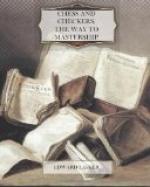The position of Diagram 76 is an example of how a problem should not be constructed. There is a tremendous number of pieces on the board which have nothing to do with the idea of the problem. The latter is one of the most primitive ideas used in problem composition and has been expressed by many composers in charming forms, so that there was no need for the above monstrous addition to the problem literature. The key move is Q-h7 so as to pin the Rook f5 in case Black plays K-d3 and to enable the mate (2) Rxf3. However, if Black replies (1) ..., P-d3 or Bxe1, neither the Queen nor the Rook f4 are necessary, but the mate is accomplished by some of the other white pieces which are lavishly distributed over the board.
+---------------------------------------+ 8 | | | | | | | | ^Q | |---------------------------------------| 7 | | | | | | | | | |---------------------------------------| 6 | ^Kt| | | | #P | | | | |---------------------------------------| 5 | | | ^P | | ^P | #R | | | |---------------------------------------| 4 | ^B | | #P | #P | | ^R | | | |---------------------------------------| 3 | #P | | #K | | | #P | ^Kt| | |---------------------------------------| 2 | ^P | | | #B | | ^P | | | |---------------------------------------| 1 | ^K | #Kt| | ^R | ^B | | | | +---------------------------------------+ a b c d e f g h
Diagram 76.—Mate in Two Moves
A striking contrast will be found in the following problem which is based on the same idea but in which all unnecessary material is dispensed with.
The key move is B-c1, in order to mate with the Queen on b3 in case Black takes the Rook a3. If Black moves the Rook, White mates by Qxb6, and if the Pawn b6 advances (2) Qxe7 is mate.
+---------------------------------------+ 8 | | ^K | | | | | | | |---------------------------------------| 7 | | | | | #P | ^B | | | |---------------------------------------| 6 | | #P | | | #Q | | | | |---------------------------------------| 5 | | | | | ^P | | | | |---------------------------------------| 4 | | #K | | | | | | | |---------------------------------------| 3 | ^R | | | | ^B | | | | |---------------------------------------| 2 | | #R | | | | | | | |---------------------------------------| 1 | | | | | | | | | +---------------------------------------+ a b c d e f g h
Diagram 77.—Problem No. 1.
Mate In Two Moves.
In problem No. 2 the mating maneuver does not involve a special trick; the idea of the composer was merely to arrive at an extraordinary mating position, and he added considerably to the value of the problem by producing the same mating position in several variations. The key move is B-b3+. Black has three moves in reply. If K-e4, White mates by (2) Q-f2, K-d3; (3) Q-f3. If K-c6, the mate is accomplished by (2) B-b4, K-b5; (3) Q-b7; and if K-d6, White answers (2) B-c4, K-c6; (3) Q-c7 mate.




